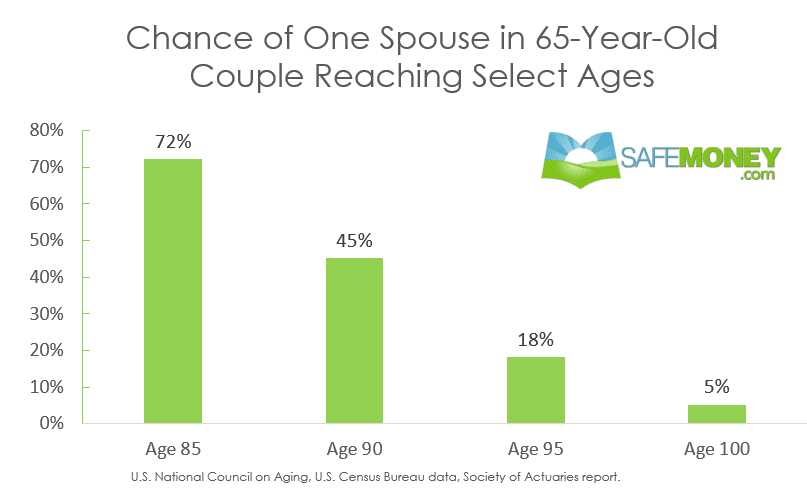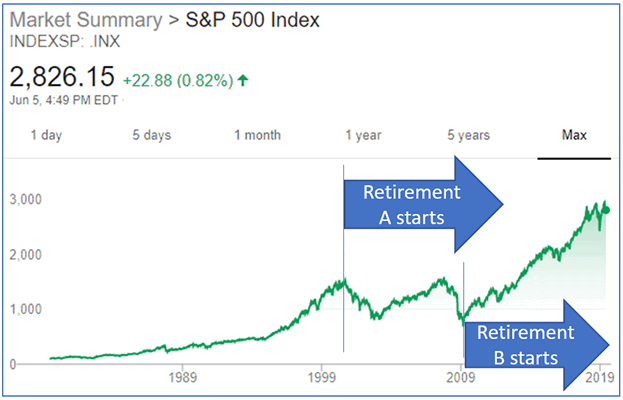5 Steps for Managing Longevity in Retirement

While retirement has many hard-to-predict moving parts, like what your spending might look like, perhaps one of the most difficult questions to answer is this: “How long will you live?”
Thanks to advances in healthcare and technology, people are living longer. According to the Social Security Administration, the statistical average for a 65-year-old man is to age 84. For a 65-year-old woman, it’s 87.
Economists call the possibility of spending decades in retirement a “longevity risk.” Still, keep in mind those numbers are just averages. What someone’s longevity looks like on a personal level will depend on their family history, health status, and lifestyle choices over the years, among other things.
For many people, the uncertainty adds up to financial concern. In one survey, almost two-thirds of surveyed Americans said they worried about running out of money in retirement more than death!
However, if you are to have a Retirement Plan that guides you across the Arc of Retirement, you will need some guestimate of how long you might live. That way you don’t underspend or overspend your financial resources.
Here are five steps to help keep longevity risk at bay and tame the uncertainty.
STEP 1: Establish a Benchmark Age for Income Planning
When you reach your 50s, one of the most important steps is planning for how much income you will need in retirement. Not only that, it’s equally important to chart out from where those income streams will come.
Because it’s the endpoint of the retirement timeline for receiving lifelong income, the age you expect to live to is a critical benchmark. Working with your trusted financial professional and your spouse, come up with what we can call a “probable longevity number.”
Some planning software programs use life expectancy in their long-term forecasts for retirement asset growth, income and spending. A more prudent strategy would be to use age benchmarks that go beyond life expectancies. Why?
Going Beyond Life Expectancy
As statistical averages, life expectancies don’t necessarily capture the full picture. The Social Security Administration observes this in relation to their life expectancy data:
“When you are deciding when to start receiving retirement benefits, one important factor to take into consideration is how long you might live.
According to data we compiled: A man reaching age 65 today can expect to live, on average, until age 84.0. A woman turning age 65 today can expect to live, on average, until age 86.5.
And those are just averages. About one out of every three 65-year-olds today will live past age 90, and about one out of seven will live past age 95.”
What’s more, among people who are married, the odds are high for one of them to live past life expectancy.
According to the Society of Actuaries, there is a 72% chance one of them will live to age 85. What about age 90? There is a 45% probability that one spouse will reach that age. Probabilities for other select ages can be seen in the graph below.

By establishing an age benchmark that goes beyond just expected lifespans, your income strategy can benefit from the increased security of this “better-safe-than-sorry” approach. Many financial professionals report using benchmarks that go into mid-to-late 90s, according to this 2016 article by InvestmentNews.
Work with your financial professional to find a prudent, and appropriate, age benchmark that’s right for your income planning timeline.
STEP 2: Set Up Your Baseline 30-Year-Retirement-Plan for 3 Scenarios
Using your “30-Year-Retirment-PLAN.xls,” create three retirement income plans for the following longevity scenarios:
- Living to the “Most Probable Longevity Number” (MPLN)
- Living to 10 years less than the MPLN
- Living 10 years beyond the MPLN
Having these three scenarios mapped out can be beneficial in a number of ways.
It can help you structure different timelines for lifelong-held goals and objectives. It gives some backup plans if something doesn’t go according to your primary plan. And it helps you visualize, on paper, how spending, income, or other factors can be adjusted if changing circumstances call for it.
STEP 3: Cover Your Living Expenses with Guaranteed Lifetime Revenues
Within each scenario from STEP 2, follow these principles:
List your Priority #1 “basic survival expenses” that are essential and non-discretionary. Traditionally, these expenses include:
- Home: mortgage P&I, insurance, real estate tax
- Household: cash, groceries
- Utilities: garbage, power, water, sanitary, cell phone
- Medical: out-of-pocket doctor, dentist, eyecare, drugs, Medicare premiums
- Income Taxes: federal, state, city
Plan to cover your Priority #1 expenses with guaranteed lifetime income streams, no matter how long you live. Some options in your income toolkit might include:
- Traditional lifetime annuity pension; and/or,
- Social Security benefits for both you and your spouse; and/or,
- Private annuity payouts; and/or,
- Required minimum distributions from 401(k), 403(B), 457, IRA, and Roth accounts.
Planning for Reliable Lifelong Income Certainty
Keep in mind that annuities are the only private-sector financial products capable of generating a guaranteed lifetime income. For retirees who worry about having enough income each year, here’s another helpful guideline to keep in mind: Spend less than you earn every year and save the surplus.
There is another strategy that follows the arc of retirement across the decumulation phase. From the “go-go” (60-75), to the “slow-go” (75-90), into the “no-go” (90+) years, reduce your expenses as much as you can each year to mitigate inflation.
This strategy calls for doing this while maintaining an acceptable and comfortable quality-of-life. Besides a “decreasing spending” strategy, there are other possibilities with different kinds of income payouts that you can use to combat inflation.
STEP 4: Test for Sequence Risk
Repeat STEP 3 using at least two different “Sequence Risk” scenarios.
What this basically means is that the stock market will go up and down over time. History shows that over the long run (20 years or more), the market generally goes up 9% annually, on average, or more.
However, timing is critical. Depending upon when those down-and-recover periods come in relation to your projected retirement period (“Period A” vs “Period B” as examples shown below), sequence risk can have a substantial impact.

This can have a drastic effect on the overall performance of your retirement financial portfolio – and by extension, your retirement lifestyle. Your financial professional can help you create a strategy that helps guard against this risk.
STEP 5: Rinse and Repeat Your PLAN
Retirement isn’t a set destination, but a moving target.
You don’t want to underspend or overspend in retirement. You worked hard to reach this point!
So, the best way to stay on track and optimize your finances is to update your PLAN.xls, each and every year, based on changing circumstances and the values of your various accounts.
If you work to develop a financial plan like the Step 1-5 Plan.xls outlined above, you will be way ahead of the game!
Prepare for a Financially Confident Lifestyle
Do you need help in putting your financial and income goals in order? Do you think that your existing retirement plan could use a second look?
If you are ready for personal guidance, financial professionals are ready to help you at SafeMoney.com. You can request a no-obligation first appointment to discuss your retirement financial picture.
Use our “Find a Financial Professional” section to connect with someone directly. Should you need a personal referral, call us at 877.476.9723.








